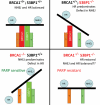BRCA1, PARP, and 53BP1: conditional synthetic lethality and synthetic viability
- PMID: 21278454
- PMCID: PMC3030974
- DOI: 10.1093/jmcb/mjq055
BRCA1, PARP, and 53BP1: conditional synthetic lethality and synthetic viability
Abstract
BRCA1 plays a critical role in the regulation of homologous recombination (HR)-mediated DNA double-strand break repair. BRCA1-deficient cancers have evolved to tolerate loss of BRCA1 function. This renders them vulnerable to agents, such as PARP inhibitors, that are conditionally 'synthetic lethal' with their underlying repair defect. Recent studies demonstrate that BRCA1-deficient cells may acquire resistance to these agents by partially correcting their defect in HR-mediated repair, either through reversion mutations in BRCA1 or through 'synthetic viable' loss of 53BP1. These findings and their clinical implications will be reviewed in this article.
Figures




References
-
- Abbott D.W., Thompson M.E., Robinson-Benion C., et al. BRCA1 expression restores radiation resistance in BRCA1-defective cancer cells through enhancement of transcription-coupled DNA repair. J. Biol. Chem. 1999;274:18808–18812. - PubMed
-
- Ahel I., Ahel D., Matsusaka T., et al. Poly(ADP-ribose)-binding zinc finger motifs in DNA repair/checkpoint proteins. Nature. 2008;451:81–85. - PubMed
-
- Allinson S.L., Dianova, Dianov G.L. Poly(ADP-ribose) polymerase in base excision repair: always engaged, but not essential for DNA damage processing. Acta Biochim. Pol. 2003;50:169–179. - PubMed
-
- Ame J.C., Rolli V., Schreiber V., et al. PARP-2, a novel mammalian DNA damage-dependent poly(ADP-ribose) polymerase. J. Biol. Chem. 1999;274:17860–17868. - PubMed
Publication types
MeSH terms
Substances
LinkOut - more resources
Full Text Sources
Other Literature Sources
Miscellaneous

